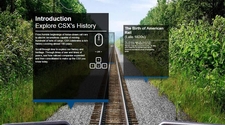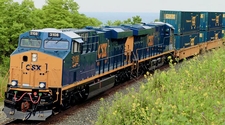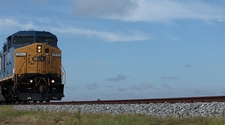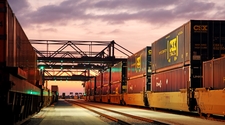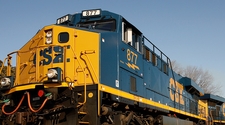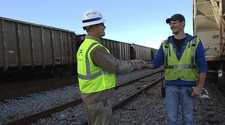| Rack Car |
A freight car having a floor laid over the sills, and equipped with racks at both ends, used primarily for transporting pulpwood. Also refers to an auto rack car (bi-level or tri-level). |
| Racks |
Shipping devices used to hold automobile parts during transit. See Auto Rack Car. |
| Radio Controlled Engine |
An unmanned engine situated within the train separated by cars from the lead unit, but controlled from it by radio signals. |
| Rail |
A length of track, usually 39 feet long. |
| Rail Bond |
A metallic connection attached to adjacent rails to ensure electrical conductivity. |
| Rail Brace |
A device used at switches, moveable point frogs, etc., in combination with the switch, tie or gauge plates for holding the rail in place. |
| Rail Freight Car
|
A car designed to carry freight or non-passenger personnel by rail and includes: box car, flat car, gondola car, hopper car and tank car.
|
| Rail Inc. |
The MIS (Management Information System) division of the Association of American Railroads. |
| Rail Joint |
A fastening designed to unite abutting ends of rails. |
| Railroad Error |
Freight charges that have been accrued because of an error by railroad personnel. Example: Shipment moves over a route other than indicated on the bill of lading. |
| Railway Labor Act |
A Federal Act providing for adjustment of disputes between railroads and employees. |
| Ramp |
See Circus Ramp. |
| Ratchet |
A serrated edge (like that of a saw), sometimes straight and sometimes on a wheel, into which a pawl engages, for producing or (more commonly) restraining motion. See Brake Ratchet and Brake Pawl. |
| Rate |
The authorized price for transportation services. |
| Rate Basing or Rate Breaking Point |
Points at which rates are made or at which rates are divided. |
| Rate Factor |
A rate that is added to another rate or rates in order to construct a through, combination or aggregate rate from origin to destination of a given shipment. |
| Rate Master |
A computer database with applicable rates for repetitive movements. |
| RCAF Rate Increase (Rail Cost Adjustment Factor) |
Rate increase based on volume of business. |
| RCCR Rate Increases (Railroad Carrier Cost Recovery) |
Increases to freight rates published in a tariff to cover higher cost of doing business. |
| Rear End Valve (AKA Caboose Valve) |
An air valve, either portable or permanently connected to the brake pipe on a caboose or other rear end car for the purpose of applying air brakes from the rear of the train. |
| Reasonable Dispatch |
The normal time required to transport a shipment from origin to destination. |
| Rebill |
A process for generating a new, or adjusted, computer billing. |
| Rebill Balance Due |
A process for generating a computer balance due freight bill. |
| Received |
See Interline Received. |
| Receiver Display Unit (RDU) |
A device on an engine that receives and displays information transmitted by an end of train device. See Head of Train Device. |
| Receiving Track |
A track used for arriving trains. |
| Receiving Yard |
A section of a yard in which one or more receiving tracks are located. |
| Reciprocal Switching |
A mutual interchange of inbound and outbound carload freight which is switched to or from a siding or another carrier under a regular switching charge. The charge is usually absorbed by the carrier receiving the line haul. |
| Reclaim |
The right to recover car hire as provided in Car Hire Rules. |
| Reconsignment |
Change in destination or routing before arrival of shipment at original destination. A change made in the instructions covering a shipment in transit - may be a change in destination, route, name of consignee, name of consignor, party to notify, etc. |
| Rectifier |
A device which converts alternating current into uni-directional current by virtue of a characteristic permitting appreciable flow of current in one direction only. |
| Red Board |
A fixed signal to stop. |
| Reefer (Slang) |
See Refrigerator Car. |
| Refining in Transit |
Stopping a shipment of sugar, oil, etc., at a point between its origin and destination for the lading to be refined. |
| Refrigeration Charge |
A fixed charge for refrigeration from origin to destination for a portion of the trip. |
| Refrigerator Car |
A specially constructed box car, insulated and equipped with ice bunkers or baskets, or a mechanical cooling system and usually adapted for the installation of heating units, used primarily for the movement of commodities that need protection from heat or cold. |
| Refund |
A reduction in revenue based on certain conditions. Some types of refunds are: Up-front: Reducing the freight price used to rate the move. After-the-fact: A rebate given after the move has occurred. One-time: An incentive given to encourage shipping. |
| Refused (Rejected) Freight |
Freight which the consignee or owner will not accept. |
| Register (Train) |
A book or form used at designated stations for registering signals displayed, the time of arrival and departure of trains and such other information as may be prescribed. |
| Register Station |
A station at which a train register is located. |
| Regular Link (AKA Straight) |
Patron's local address is linked to same patron's billing address. |
| Regular Train |
A train authorized by a timetable schedule. |
| Regulating Valve (AKA Feed Valve) |
A valve that reduces main reservoir pressure to a lower pressure for charging the equalizing reservoir and brake pipe. |
| Relay Train |
A train with one or more blocks of cars which remain intact through one or more crew change points. |
| Relay, A.C. |
A relay designed to respond to alternating current. |
| Relay, Biased |
A relay which will operate to its energized position by current of one polarity only, and will return to its de-energized position when current is removed. |
| Relay, Code Following |
A relay which will follow or reproduce a code without distortion within practical limits. |
| Relay, D.C. |
A relay designed to respond to direct current. |
| Relay, Flasher |
A relay so designed that when energized its contacts open and close at pre-determined intervals. |
| Relay, Interlocking |
A relay having two independent magnetic circuits with their respective armatures so arranged that the dropping away of either armature prevents the other armature from dropping away to its full stroke. |
| Relay, Line |
A relay receiving its operating energy through conductors of which the track rails form no part. |
| Relay, Magnetic Stick |
A relay, the armature of which remains at full stroke in its last energized position when its control circuit is opened. |
| Relay, Neutral |
A relay which operates in response to a pre-determined change of the current in the controlling circuit, irrespective of the direction of the current. |
| Relay, Overload |
A relay which operates to open contacts when the current through its control coil exceeds a pre-determined value. |
| Relay, Polar |
A relay which operates in response to a change in the direction of current in its controlling circuit and the armature of which may or may not remain at full stroke when its control circuit is interrupted. |
| Relay, Power Off |
A relay so connected to the normal source of power supply that the failure of such source of power supply causes the load to be transferred to another source of supply. |
| Relay, Quick Drop-Away |
A relay which, when the controlling circuit is opened or completely shunted will release quicker than an ordinary relay. |
| Release |
Patron's notice to the railroad that a car is loaded or unloaded and ready to be moved from his industry. Also a car that can be moved from one status to another (i.e. bad order to OK status). |
| Release Cock |
See Release Valve. |
| Release Form |
A computer-generated form, advising of a train bulletin number and the number of train messages it must contain. Its address must correspond to the associated train bulletin. |
| Release Rod |
A small iron rod generally located at the side of a car for the purpose of operating the air brake release valve. |
| Release Valve |
A valve attached to the auxiliary reservoir for reducing the air pressure when the locomotive is detached so as to release the brakes. |
| Released Value (AKA Limited Liability) |
A rate subject to limitations respecting the liability of the carrier in case of loss or damage to the shipment. |
| Reload |
Term used to designate a car (inbound load) which is unloaded and then reloaded by that same customer for an outbound move. |
| Remote Unit |
See Radio Controlled Engine. |
| Remotely Controlled Railroad Crossing (AKA Diamond) |
A railroad crossing at grade operated by a control station. |
| Repair Track |
A track designated for use to repair cars. |
| Reparation |
Amends for a wrong done. |
| Reparation Claim |
A request to correct an unjust or unreasonable published rate assessed on a shipment. Reparation claims must have the approval of the STB. |
| Replacer |
A portable metal device utilized for the rerailing of derailed equipment. |
| Reporting Date |
Date the document is processed into the account. |
| Reporting Marks |
The alphabetic initials stenciled on the sides and ends of every freight car to identify the railroad or private car line that owns the car. Reporting marks are assigned by the Association of American Railroads, and in conjunction with the car number, serve to uniquely identify every car in the interchange fleet. |
| Reporting Station |
Agency that actually reports the waybill. May differ from station where the shipment terminated. |
| Reporting the Waybill |
Processing the coded and rated waybill through data entry or releasing a waybill from suspense. |
| Rerailer |
A device connected to the track, used to return a derailed car onto the track. |
| Reservoir |
A cylindrical container for the storage of air under pressure. Main reservoirs of large capacity are located in locomotives and under all motor cars having air compressors; auxiliary and emergency reservoirs are located under the cars. |
| Reshipment |
Goods re-forwarded under conditions which do not make them subject to the reconsigning rules and charges of the carrier. |
| Residue |
The hazardous material remaining in a packaging, including a tank car, after its contents are unloaded but before being cleaned and purged. |
| Restart |
A process to recycle the credit period of a freight bill. |
| Restricted Equipment |
A shipment requiring specific operating handling procedures for safe movement. |
| Restricted Rate |
A rate published from and to specified points which has limited application. Restricted rates are to apply only on shipments originating at one destination for specific points and are not to be used in constructing combinations. |
| Restricted Speed |
A speed that will permit stopping within one-half the range of vision. It will also permit stopping short of a train, a car, an obstruction, a stop signal, a derail, or an improperly lined switch. It must permit looking out for broken rail. It will not exceed 15 mph. |
| Retainer (Retainer Valve) |
A manually operated valve, found on all freight and some passenger cars, which controls the exhaust of brake cylinder pressure. |
| Retaining Valve |
A small manually positioned valve located near the brake wheel for retaining part of the brake cylinder pressure, to aid in retarding the acceleration of a train in descending long grades. |
| Retarder |
A mechanical device usually located in a hump yard, used to slow rolling stock to a safe coupling speed, similar to the hand brakes on a bicycle. |
| Return on Equity |
Net income divided by average stockholder's equity. |
| Revenue |
Income from freight charges assessed. |
| Revenue ton-mile |
The movement of a ton of freight one mile for revenue. |
| Revenue Waybill |
A waybill showing the amount of charges due on a shipment. |
| Reverse Lever |
The lever which controls the direction of motion of the locomotive by reversing the traction motor field connections. |
| Reverse Route |
Returning a car the same route as shipped. |
| Ribbon-Rail |
Term used to describe rail which has been welded together at the joints effecting a smoother ride. |
| Right of Way |
In the strictest sense, land or water rights necessary for the roadbed and its accessories. However, it is now loosely used to describe property owned and/or operated over by a railroad. |
| Ring Master |
See Yardmaster. |
| Rip (Slang) |
Car in need of repair. |
| Rip Track |
A track on which cars are placed for repairs. |
| Riprap Territory |
A portion of the railroad where the grade is undulating. |
| Road Haul |
Movement of cars from one station to another for a revenue rather than for a switching charge. |
| Road Mate (AKA Mate) |
A cab-less locomotive slug unit, not equipped with a diesel engine, but equipped with MU capability and traction motors, which receive electrical power from a mother locomotive. |
| Road Slug |
A locomotive unit equipped with an operating cab, but not equipped with a diesel engine. This type unit has MU capability and traction motors, which receives electrical power from a mother locomotive. |
| Roadbed |
The foundation on which a track and ballast rest. |
| Roadrailer |
Truck or trailer with two sets of wheels, one set for use on rail, and one set for the highway. |
| Roadway |
See Right of Way. |
| Roll-By (Slang) |
Making a check of cars as they pass. |
| Roller Bearing |
The general term applied to a group of journal bearings which depend upon the action of a set of rollers to reduce rotational friction. |
| Roller Bearing Adapter |
Each location on a truck side frame where support is provided by contact with a roller bearing journal. |
| Rolling Stock |
Transportation equipment on wheels. |
| Root (ARZ) |
First four (4) digits of the six-digit patron code. |
| Rotair Valve |
A valve used with 24RL equipment for cutting in and cutting out the independent brake valve. |
| Roundhouse |
The building used to house engines while they are being serviced or repaired. |
| Route |
Noun: The course or direction that a shipment moves. Verb: To designate the course or direction a shipment will move. |
| Route Locking |
Electric locking, effective when a train passes a signal displaying an aspect for it to proceed, which prevents the movement of any switch, moveable point frog, or derail in advance of the train within the route entered. It may be so arranged that as a train clears a track section of the route, the locking affecting that section is released. |
| Rubber Interchange |
The exchange of trailvan shipment between railroads using a drayman company to move the trailers/containers via highway. |
| Rule 11 |
Freight Mandatory Railway Accounting Rule 11 is invoked when traffic is tendered as interline forwarded and "through pricing" does not exist. Rule 11 requires the following be included on the waybill: a shipper/agent code of "R", the name and address of the party responsible for payment of transportation charges, and notation that shipment is a Rule 11 shipment to be re-waybilled by the connecting carrier. |
| Rule 24 |
Uniform Freight Classification Tariff (UFC 6000). Freight in excess of full carload (Lead and Follow Cars). Shipment must be by one shipper, from one station, shipped on the same date and listed on one bill of lading. Two cars may use the same rate without having to meet the full weight requirement on the follow car. Will not apply on bulk or livestock shipments. |
| Rule 29 |
Uniform Freight Classification Tariff (UFC 6000). Shipment requiring two or more open cars to accommodate long or bulky articles. No series of more than four car minimum weights will apply on all lead cars with 24,000 minimum (unless tariff excepted) on each idler. |
| Rule 35 |
Uniform Freight Classification Tariff (UFC 6000). Covers rules and regulations on tank car freight shipments. |
| Ruling Grade |
That section of track, which will offer the most resistance to train movement between two specific points. |
| Rump Rail |
A side slat on a single-deck stock car made heavier than the usual slats. It is placed about four feet above the floor to resist movement of cattle against the car sides. |
| Run Through A Switch |
To go through a switch without lining it for the movement, bending the switch points. |
| Run-Around |
The term used to describe the move necessary if a car is to be set-out on a facing point siding. Engine cuts off and runs around train on nearest double-ended siding, couples to rear of train and switches cars into and out of siding as desired. A wye track or balloon track can do the same thing. |
| Run-In |
A term used to describe the relative movement of cars in a train to a state of buff or compression. |
| Run-Out |
The relative movement of cars in a train to a state of draft or tension. |
| Runaway Track |
A track built for the purpose of accepting cars that are out of control (runaways). |
| Running Gear |
A general term applied to the truck (and its appliances) of a freight car or locomotive. |
| Running Release |
Release of an automatic brake service application while the train is still in motion. |
| Running Repairs |
Minor repairs of railway equipment. |
| Running Track |
A track designated in the timetable upon which movements may be made subject to prescribed signals and rules, or special instructions. OR A track reserved for movement through a yard. |
| RWC Number (AKA Profile Number) |
Repetitive waybill coding number. |
| back to top |


